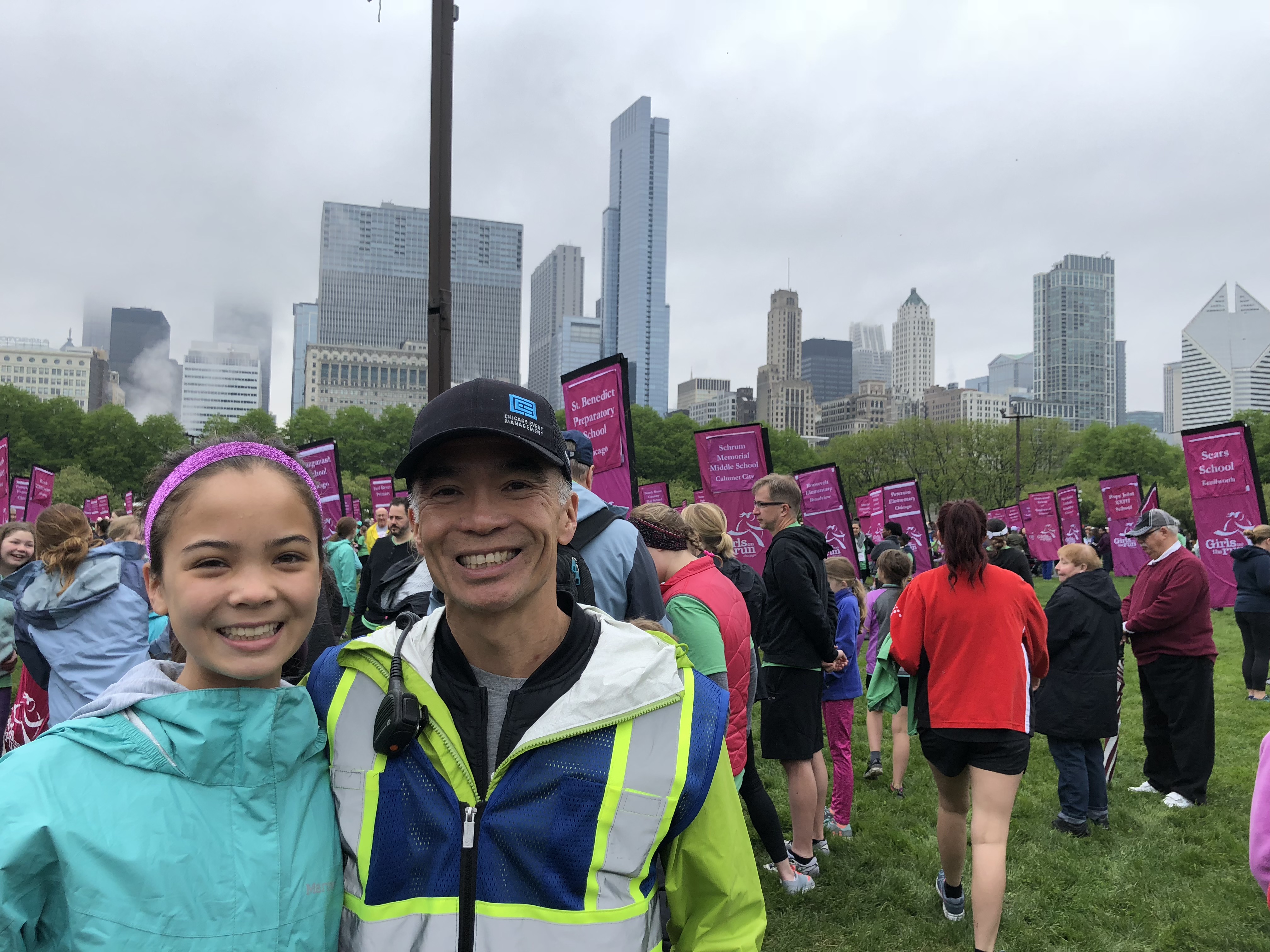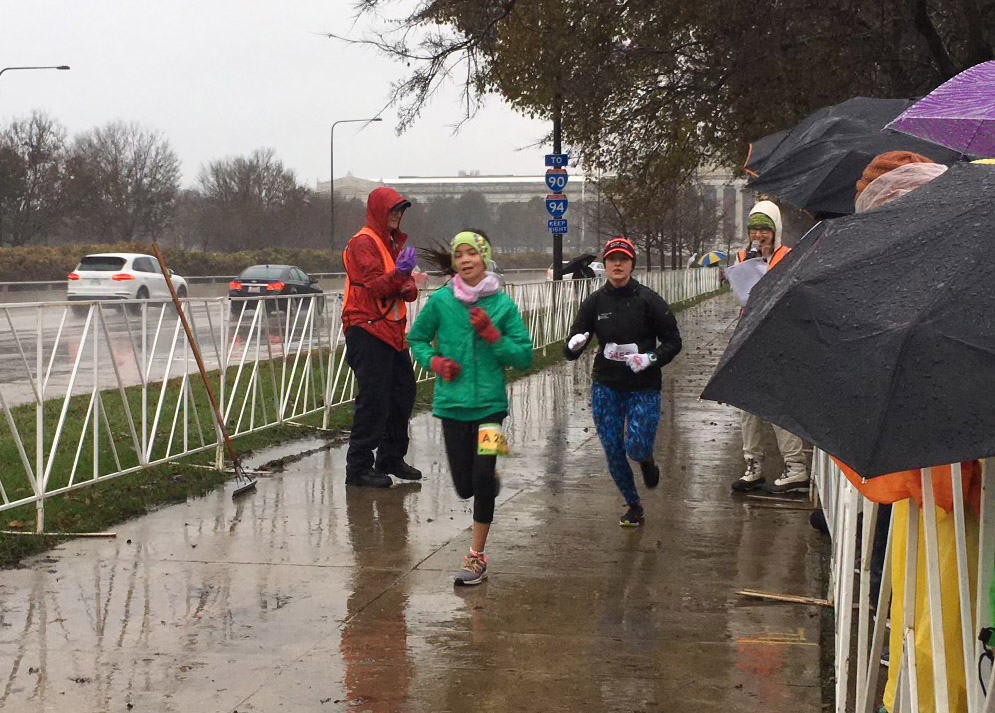Name: Nora Nishi
Age: 17, senior in high school
GOTR Name: Nice Nora
GOTR Team: 6th and 7th grade at Urban Prairie Waldorf School in Chicago, IL
Training for a marathon is hard work for anyone, but if you add it to going to high school and doing homework, only the most determined make it across the finish line. On January 15, 2023, high school senior and Girls on the Run-Chicago alum Nora Nishi took on the challenge and finished the Houston Marathon, achieving her goal that took seven months of preparation.
Nora grew up steeped in the Chicago running community, thanks to her Dad Mike Nishi, who has served on the Girls on the Run-Chicago Governing Board for 15 years and is the Chief Operating Officer & Partner, Chicago Event Management, the event company that puts on some of Chicago’s most iconic races, including the Bank of America Chicago Marathon, Chicago 13.1, and Shamrock Shuffle. She began volunteering at these races as far back as she can remember, and even received her first “official” volunteer position at the Chicago Marathon in sixth grade.
Inspired by Mike and the enthusiastic Chicago running community, she joined the Girls on the Run-Chicago program at her middle school, Urban Prairie Waldorf School, and participated in four seasons throughout sixth and seventh grade. Her experience in Girls on the Run deepened her love for running, and she continues to draw from her GOTR days to tackle marathon training and school work. She’s gone on to complete internships at both the Chicago and Berlin marathons, as well.
We sat down to chat with 17-year-old Nora about how her Girls on the Run experience helped her reach her goal of running her first marathon as a high school student.

What made you decide to run the Houston Marathon?
I ran the marathon for a school project—to run a marathon and document my training process. I knew if I didn’t finish the marathon, I wouldn’t have a project to present, so at first, that was the main thing that was moving me through. But [as I started training], I thought, you know what, I’m actually doing this for myself.
What was your favorite part of running the race?
The spectators. That was one of the most energizing parts because everyone had their names on their bibs, so the crowd is shouting your name and it was so exciting. That, or right when I finished. Even when I could see the finish line, it didn’t feel like I was going to finish, I didn’t know if I had it in me to walk 20 more feet. But as soon as I finished, it was the happiest I have ever been.
It was better than I thought. I’ve worked so many of the Chicago Marathons, and whenever I see people cross the finish line, they look so exhausted. I had it in my head that I would be dying at the end, but it wasn’t horrible [laughs].
What was your biggest challenge during the race?
Being by myself the whole time. After a while, my headphones died, so I was just alone with my thoughts. The hardest part was ignoring myself, because I would think things like, “Oh, my feet hurt, I need to stop!” But you have to push through what you’re thinking, and that was really hard for me to do. I couldn’t get past that for a while, but at a certain point I thought, “Okay, I’m the only one that’s setting myself back right now. I have to accept that, and just get through it.” That was challenging!
What was your training plan like and how did you balance training and school?
I started training in June. The longest I had ever run before was 6 miles, so I had a 6-week training plan for a 10K and hit that in August. Then I had a 20-week marathon training plan. I originally planned on running the Dallas marathon, but I started getting shin splints in August, so from mid-August to mid-Sept i didn’t run, because in order to have shin splints go away, you just can’t put pressure on them. I went to PT to learn exercises to strengthen my hips and calves.
It was a little detour, but that’s okay. All in all, I had 7 months of training, which seems like a lot [laughs]. It was hard when school started to keep up with not just the running, but the strength training. I tried to do all my homework in school during breaks.
Do you remember finishing your first 5K with GOTR?
I remember running it! I was thinking, “This isn’t so bad,” because during practice, I would always run too fast, and then I would be exhausted at the end. Because I had my buddy with me during the race, we started the pace slow, which was great. I remember feeling great at the end, because I had so much energy left and I conserved it so well. I just remember that feeling, because I was surprised—I thought a 5K should feel harder than this.

Did you apply anything you learned from GOTR to your training or during the race?
One thing I remember is something my coaches told me about running form. At practice, I’d always choke up my arms, and one of my coaches would always say, “Click it through your hips—make sure your thumbs touch your hips.” That’s all I was thinking at the start of the marathon—I had to keep my form good so that I’d be okay at the end. So that definitely helped me throughout the years with my running form.
But I think also just the sense of community. I remember running with all my friends, socializing first, and then being able to carry that through the running was so important for me in middle school, especially—a way to connect with friends in a different way. I felt that at the very end of the marathon, because everyone was walking a bit together. At the end, the support of the crowd really motivated me, so then I started yelling at other people, stuff like, “Come on, you can do this,” and it reminded me so much of when I was in 6th grade yelling at my friends and they were yelling at me to keep running. So that was a really good parallel.
What would you say to your 10-year-old self about working toward and achieving this goal?
I think it goes back to believing in yourself. Focus on yourself. Don’t compare yourself to any other runners or your friends during practice. Think about what your own goal is for the race or run, and try to achieve that.
Has running helped you get through or overcome difficult times?
Usually when I’m stressed or not feeling right, I need to go for a run and use it as a reset button. Because I know that even if it hurts during the run, after the run I always feel amazing. So whenever I’m stressed from school, specifically, I know right after school that I’m going to change and go for a run. I use that time to connect with myself and get my thoughts aligned. I did that a lot during the pandemic with my neighbor. He also likes to go on runs, so we’d always go on runs together and I used that as a break from everything. It’s my outlet.
How do you stay motivated to run on tough days?
There’s a couple of things. The first thing is music. I need the music to stay motivated while I’m running. I also have a friend I made this summer. She and I both had an internship at the Berlin Marathon, and we’re running buddies, so we run together all the time. Now, whenever I don’t want to run, I think, “Okay, would she run? Yes. So I should run.” Having that connection with someone else is important for me.
I also know that if she were with me right now, she would have full faith and believe in me. So I should just believe in myself, and use that to believe in myself.
As you might remember, in the Girls on the Run program, we teach girls to identify their Star Power—that special quality that makes them unique. What is your Star Power?
I would say my Star power is because of running: Perseverance. I learned that from the long runs. You just have to keep pushing through, and believe that you can do it.
Do you apply anything you learned from GOTR to your day-to-day life now?
Yes, right now I’m relying on perseverance in my math class. It’s been challenging, but I know that I’ve already done most of the work, and I just need to see it through: Perseverance.
GOTR really helped bring a positive outlook to running, because it was such a fun thing to experience. Running doesn’t always have to be like, “Oh, this hurts,”—Girls on the Run helped me think about the good in it. At practice, as we ran laps we would have to think about certain topics and answer questions while we ran, which made it more fun. I like learning all those little tricks to teach yourself to like running and appreciate it more, so I’m very grateful that Girls on the Run gave me that positive and happy outlook. It also really showed that running is a team effort.
What’s your next big goal?
I’m hoping to run another marathon in the next year to year-and-a-half. I’m just trying to finish senior year right now! I’m also applying to go to university in Germany.
Are you feeling inspired by Nora's story? Start your own marathon journey by becoming a SoleMate charity athlete!